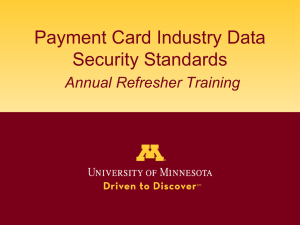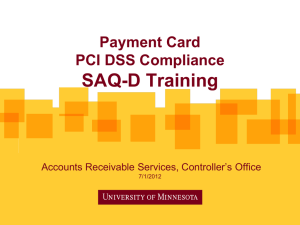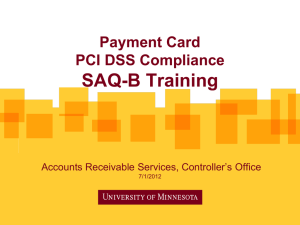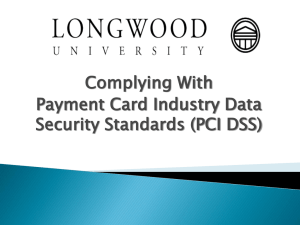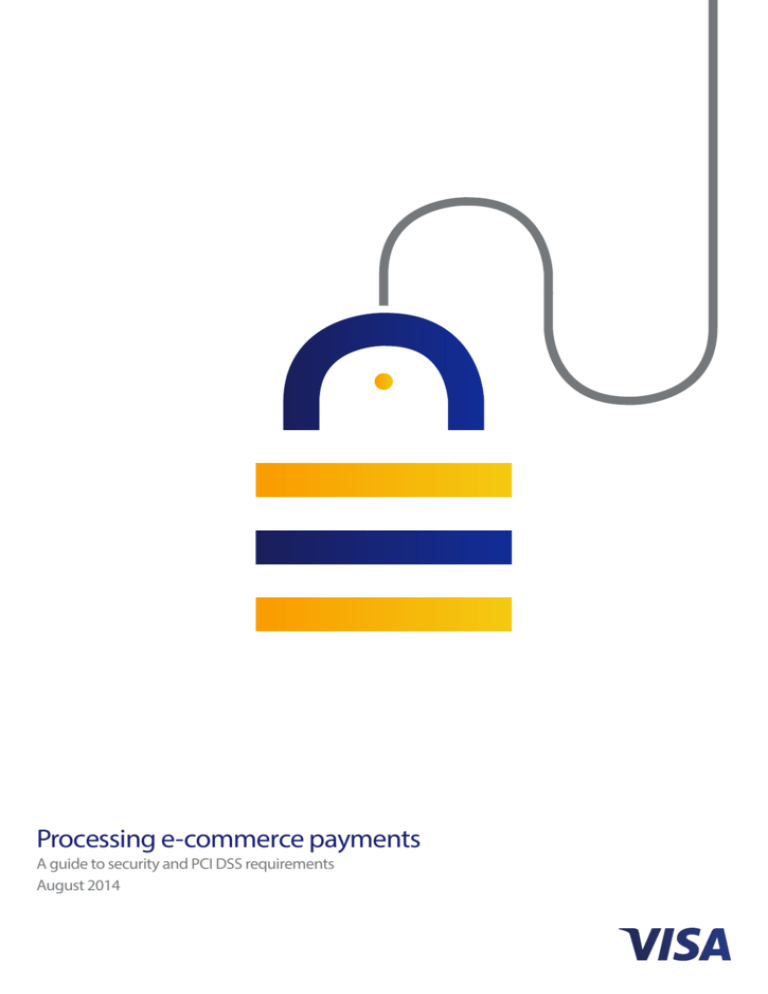
Processing e-commerce payments
A guide to security and PCI DSS requirements
August 2014
Contents
Foreword by Peter Bayley
3
The systems involved
4
The key steps involved
4
The Payment Card Industry (PCI) Data Security Standard (DSS)
5
The redirect process
6
The IFRAME
8
The direct post
10
The JavaScript created form
12
The API
14
Processing e-commerce payments
A guide to security and PCI DSS requirements
There are a number of ways to secure
e-commerce transactions. How a website asks
for the payment data and what happens to the
data once the customer clicks ‘OK’ can affect the
security of the transaction.
This guide:
• Shows the various common ways that websites
ask for payment card data.
• Describes the PCI DSS requirements of the
merchant’s website.
• Explains how criminals try to disrupt the
payment flow to capture cardholder data.
Processing e-commerce payments. A guide to security and PCI DSS requirements
2
Foreword by Peter Bayley
Wherever cardholder data is processed,
criminals will try to find ways to steal that data
to commit fraud. In the past three years we’ve
seen many innovative ways that merchants
have chosen to process cardholder data for
e-commerce transactions. The criminals have
also noticed that some of these new methods
of processing data are easier to compromise
than others.
The Payment Card Industry Security
Standards Council recently released PCI DSS
version 3.0 along with a new self-assessment
questionnaire for some e-commerce
merchants (SAQ A-EP). A number of the
changes in this new version of DSS have been
introduced to help acquirers, merchants and
their Qualified Security Assessors secure
cardholder data in an online environment.
The new standard can be used today, and is
mandatory from the start of 2015.
I understand that when new versions of the
standards are released, it can cause confusion
and may influence merchants to change the
way they process transactions. Visa Europe has
produced this guide to explain the minimum
requirements we expect of merchants to
secure cardholder data and how merchants
should report their PCI DSS compliance to an
acquiring bank. We’ve illustrated the cardholder
data flow for typical e-commerce transaction
architectures, described the risks and stated
our compliance requirements for each one.
I hope this helps your understanding of the
new standards and the risks associated with
processing cardholder data.
Peter Bayley
Executive Director, Risk Management
“In the past three years we’ve seen
many innovative ways that merchants
have chosen to process cardholder
data for e-commerce transactions.”
Processing e-commerce payments. A guide to security and PCI DSS requirements
3
The systems involved
Three computer systems are involved whenever a customer
makes a card purchase on the internet.
The merchant website
Contains the product catalogue
and shopping cart. Always
starts the process to collect
the customer’s cardholder data
when the customer asks to
checkout.
The customer computer
Running a web browser such
as Firefox, Chrome or Internet
Explorer.
The payment service
provider (PSP)
A Visa Europe listed validated
PCI DSS compliant company
that receives the cardholder
data and submits it to the
payment system.
The key steps involved
There are three key, separate steps in collecting a payment from the customer;
the way that these are designed will affect the security of the transaction.
Step 1.
CREATE the payment form to
collect the customer’s card data
and SEND the payment form
to the customer computer. This
can be done by the merchant
website, or by the PSP website.
Step 2.
The customer computer
displays the payment form,
and the customer enters their
card data and presses the OK
button (often called ‘submit’
or ‘pay now’) to confirm the
payment, which tells the
customer computer to SEND
the card data to the PSP or
to the merchant website. This
step always happens on the
customer computer.
This guidance document will look at the various
ways that companies do this today, and explain
how each works and identify the systems that
make each step happen.
Step 3.
RECEIVE the card data entered
by the customer into the
payment form and then send
it to the payment system
for authorisation. This can
be done by the merchant
website, the PSP or both the
merchant website and the PSP
working together.
Important notes
• Some of the technical details of how this
happens have been simplified, to concentrate on
the flows of payment forms and cardholder data.
• All communications between the customer
computer, the merchant website and the PSP
must be encrypted.
Processing e-commerce payments. A guide to security and PCI DSS requirements
4
The Payment Card Industry (PCI)
Data Security Standard (DSS)
PCI DSS describes the way that merchants and
PSPs should secure their systems. PCI DSS applies
to all merchants that accept Visa cards and the
number of technical requirements that apply
depend on which way the merchant configures
their website to accept card payments. PCI
DSS applies to all merchants’ webservers, even
if a webserver does not itself store, process or
transmit cardholder data because the merchant’s
webserver determines how cardholder data is
processed and so can affect the security
of the transaction.
There are two ways a merchant can validate its
compliance with PCI DSS – by completing a selfassessment questionnaire (SAQ) or by obtaining a
Report on Compliance (RoC) using a PCI Security
Standards Council registered Internal Security
Assessor (ISA) or Qualified Security Assessor (QSA).
There are three options:
SAQ A / RoCA
SAQ A-EP / RoCA-EP
SAQ D / RoC
Criteria
The entire payment page is
received from and returned
to a Visa Europe listed
validated PCI DSS compliant
third party provider.
The merchant website
does not store, process or
transmit cardholder data
but controls how the data
is collected.
The merchant website
stores, processes or
transmits cardholder data.
Requirements
Merchants must ensure
they use only Visa Europe
listed validated PCI DSS
compliant third party
providers.
A sub-set of PCI DSS
requirements designed
to protect the integrity of
the merchant’s webserver
and that Visa Europe listed
validated PCI DSS compliant
third parties are used.
All PCI DSS requirements
are applicable.
Visa Europe has different minimum requirements
for e-commerce merchants depending on how
they accept cardholder data and the number of Visa
card transactions they process annually. Merchants
should contact their acquiring bank to confirm the
validation method they need to use. The risk to
cardholder data and the validation requirements
are based solely on the actual types of attacks that
Visa Europe is seeing against merchants.
The following table summarises the validation
requirements from January 1st 2015. Merchants
who meet the validation requirements will be
granted safe harbour from penalties in the event
of an account data compromise.
Merchant
Level
No of Visa
Transactions Annually
Redirect
IFRAME
Direct
Post
JavaScript
XML
Anything
else
1
Over 6 million
RoCA
RoCA
RoCA-EP
RoCA-EP
RoC
RoC
2
1– 6 million
SAQ A
SAQ A
SAQA-EP
SAQ A-EP
SAQ D
SAQ D
3
20,000 – 1 million
SAQ A
SAQ A
SAQA-EP
SAQ A-EP
SAQ D
SAQ D
4
Under 20,000
SAQ A
SAQ A
SAQA-EP
SAQ A-EP
SAQ D
SAQ D
RoCA – Partial Report on Compliance validating the scope, eligibility and requirements listed in SAQ A
RoCA-EP – Partial Report on Compliance validating the scope, eligibility and requirements listed in SAQ A-EP
Processing e-commerce payments. A guide to security and PCI DSS requirements
5
The redirect process
When the customer wants
to check out:
Merchant
Website
Step 1
The merchant website SENDS
a “redirect instruction” to the
customer computer
Customer
Computer
Payment Service
Provider (PSP)
Send
redirect
instruction
Step 2
The customer computer
REQUESTS a payment form
from the PSP
Request
payment form
Step 3
Create payment
form
The PSP CREATES a payment
form and SENDS it to the
customer computer
Step 4
The customer computer displays
the payment form
Step 5
The customer enters their card
data into the payment form and
presses the OK button
Step 6
The customer computer SENDS
the card data to the PSP
Step 7
The PSP RECEIVES the card
data and SENDS the card data
to the payment system for
authorisation
Name
Card
Expire
Cvv2
OK
Name
Card
Expire
Cvv2
OK
Name
MR A CARDHOLDER
Card
4000123456789010
Expire
12
16
Cvv2
111
OK
Send card data
Mr A Cardholder
4000 XXXX XXXX XXXX
12/16
XXX
Payment system
Processing e-commerce payments. A guide to security and PCI DSS requirements
6
The redirect process
When criminals attack the redirect
How
Criminals break the security of the merchant website and they change the
program that sends the redirect instruction to the customer computer. This tells
the customer computer to request a payment form from the criminal website
instead of the PSP. The card data entered by the customer it is sent to the criminal
and not to the PSP. Sometimes the criminal website collects the card data and
sends it onto the PSP, sometimes the criminal website gets the card data and then
tells the customer that there’s been a problem and sends an instruction to the
customer computer to now get the ‘real’ payment form from the PSP. This is known
as a man-in-the-middle (MITM) attack.
What will the
customer see?
The criminal payment form, which will be designed to look identical to the PSP
payment form and may also ask for other information such as the card holder’s PIN.
Depending on how the criminals attack, the customer may be asked to enter their
card data twice.
What will the
merchant see?
The merchant may see a loss in sales caused by an increased transaction drop-out
as customers are not taken in by the criminal’s payment form or they don’t want to
enter their card data twice.
How can the merchant
detect this attack?
The merchant should follow the Visa Europe guidance that explains how to detect
and protect against this attack.
What level of PCI DSS compliance is required for the e-commerce channel?
Merchant
PSP
Level 1
Level 2
Level 3
Level 4
RoCA
SAQ A
SAQ A
SAQ A
A Visa Europe listed validated PCI DSS compliant service provider.
Risk rating
Low – this method of processing e-commerce payments is the lowest risk for the merchant.
Processing e-commerce payments. A guide to security and PCI DSS requirements
7
The IFRAME
When the customer wants
to check out:
Merchant
Website
Step 1
The merchant website
creates a PARENT payment
page and SENDS it to the
customer computer
Customer
Computer
Payment Service
Provider (PSP)
Create parent
payment page
Step 2
The PARENT page includes an
instruction to the customer
computer to REQUEST a CHILD
PAGE containing a payment
form from the PSP
Request a child
page containing
payment form
Step 3
Create payment
form
The PSP CREATES a payment
form and SENDS it to the
customer computer
Step 4
The customer computer displays
the CHILD PAGE containing
the payment form within the
PARENT page
Step 5
The customer enters their card
data into the payment form and
presses the OK button
Step 6
The customer computer SENDS
the card data to the PSP
Step 7
The PSP RECEIVES the card
data and SENDS the card data
to the payment system for
authorisation
Name
Card
Expire
Cvv2
OK
Name
Card
Expire
Cvv2
OK
Name
MR A CARDHOLDER
Card
4000123456789010
Expire
12
16
Cvv2
111
OK
Send card data
Mr A Cardholder
4000 XXXX XXXX XXXX
12/16
XXX
Payment system
Processing e-commerce payments. A guide to security and PCI DSS requirements
8
The IFRAME
When criminals attack the IFRAME
How
The attack against the IFRAME is very similar to the attack against the redirect.
Criminals break the security of the merchant website and they change the
program that creates the parent page sent to the customer computer. Instead of
the instruction telling the customer computer to request a CHILD page containing
a payment form from the PSP, the instruction tells the customer computer to
request a payment form from the criminal web site. So when the customer enters
their card data it is sent to the criminal website and not the PSP. Sometimes the
criminal website collects the card data and sends it onto the PSP, sometimes the
criminal website gets the card data and then tells the customer that there’s been a
problem and sends an instruction to the customer computer to now get the ‘real’
payment form from the PSP. This is known as a man-in-the-middle (MITM) attack.
What will the
customer see?
The criminal payment form, which will be designed to look identical to the PSP
payment form and may also ask for other information such as the card holder’s PIN.
Depending on how the criminals attack, the customer may be asked to enter their
card data twice.
What will the
merchant see?
The merchant may see a loss in sales caused by an increased transaction drop-out
as customers are not taken in by the criminal’s payment form or they don’t want to
enter their card data twice.
How can the merchant
detect this attack?
The merchant should follow the Visa Europe guidance that explains how
to detect and protect against this type of attack.
What level of PCI DSS compliance is required for the e-commerce channel?
Merchant
PSP
Level 1
Level 2
Level 3
Level 4
RoCA
SAQ A
SAQ A
SAQ A
A Visa Europe listed validated PCI DSS compliant service provider.
Risk rating
Low – this method of processing e-commerce payments is low risk although it is more frequently attacked
by criminals than the redirect process. Merchants should ask their PSP about technical measures they can use
to best secure an IFRAME.
Processing e-commerce payments. A guide to security and PCI DSS requirements
9
The direct post
(this is sometimes also called ‘browser API’ or ‘silent order post’)
When the customer wants
to check out:
Merchant
Website
Step 1
The merchant website CREATES
a payment form and SENDS it to
the customer computer
Customer
Computer
Payment Service
Provider (PSP)
Create payment
form
Name
Card
Expire
Cvv2
OK
Step 2
The customer computer displays
the payment form
Step 3
The customer enters their card
data into the payment form and
presses the OK button
Step 4
The customer computer SENDS
the card data to the PSP
Step 5
The PSP RECEIVES the card
data and SENDS the card data
to the payment system for
authorisation
Name
Card
Expire
Cvv2
OK
Name
MR A CARDHOLDER
Card
4000123456789010
Expire
12
16
Cvv2
111
OK
Send card data
Mr A Cardholder
4000 XXXX XXXX XXXX
12/16
XXX
Payment system
Processing e-commerce payments. A guide to security and PCI DSS requirements
10
The direct post
(this is sometimes also called ‘browser API’ or ‘silent order post’)
When criminals attack the direct post
How
Criminals break the security of the merchant website and they change the
program that creates the payment form. The criminals include some script so that
when the customer enters the card data, it is automatically sent to the criminals
as well as to the PSP.
What will the
customer see?
The legitimate payment form. The customer will not notice the script running in
the background which also sends the card data to the criminal.
What will the
merchant see?
The merchant will not see any effects of this attack in their day-to-day operations.
How can the merchant
detect this attack?
As detection by the merchant is very hard, the merchant should deploy the
appropriate PCI DSS controls described in SAQ A-EP to help to prevent and
detect this attack.
What level of PCI DSS compliance is required for the e-commerce channel?
Merchant
PSP
Level 1
Level 2
Level 3
Level 4
RoCA-EP
SAQ A-EP
SAQ A-EP
SAQ A-EP
A Visa Europe listed validated PCI DSS compliant service provider.
Risk rating
Medium – this method of processing e-commerce payments is higher risk than the redirect process or the
IFRAME and is currently being attacked by criminals.
Processing e-commerce payments. A guide to security and PCI DSS requirements
11
The JavaScript created form
When the customer wants
to check out:
Merchant
Website
Step 1
The merchant website CREATES
a payment page and sends it
to the customer computer
Customer
Computer
Payment Service
Provider (PSP)
Create payment
page
Step 2
The payment page includes
an instruction to the customer
computer to REQUEST some
JavaScript from the PSP
Payment
page requests
JavaScript
Step 3
Creates and
sends Javascript
The PSP SENDS the JavaScript to
the customer computer.
Step 4
The customer computer uses the
JavaScript to CREATE a payment
form within the payment page.
Step 5
The customer enters their card
data into the payment form and
presses the OK button
Step 6
The customer computer SENDS
the card data to the PSP
Step 7
The PSP RECEIVES the card
data and SENDS the card data
to the payment system for
authorisation
Name
Card
Expire
Cvv2
OK
Name
MR A CARDHOLDER
Card
4000123456789010
Expire
12
16
Cvv2
111
OK
Send card data
Mr A Cardholder
4000 XXXX XXXX XXXX
12/16
XXX
Payment system
Processing e-commerce payments. A guide to security and PCI DSS requirements
12
The JavaScript created form
When criminals attack the direct post
How
Criminals break the security of the merchant website and they change the program
that creates the payment page that is sent to customer computer. The criminals
change the page so as well as requesting some JavaScript from the PSP, the
customer computer requests additional JavaScript from the criminal website so that
when the customer enters the card data, as well as the card data being sent to the
PSP, it is also sent automatically to the criminals.
What will the
customer see?
The payment form. The customer will not notice the additional script running in the
background of the payment form on the customer computer that also sends the
card data to the criminal.
What will the
merchant see?
The merchant will not see any effects of this attack in their day-to-day operations.
How can the merchant
detect this attack?
As detection by the merchant is very hard, the merchant should deploy the
appropriate PCI DSS controls described in SAQ A-EP to help to prevent and
detect this attack.
What level of PCI DSS compliance is required for the e-commerce channel?
Merchant
PSP
Level 1
Level 2
Level 3
Level 4
RoCA-EP
SAQ A-EP
SAQ A-EP
SAQ A-EP
A Visa Europe listed validated PCI DSS compliant service provider.
Risk rating
Medium – this method of processing e-commerce payments is currently being attacked by criminals.
Processing e-commerce payments. A guide to security and PCI DSS requirements
13
The API
(this is sometimes also called a ‘merchant gateway’ typically sending data from the merchant
to the PSP formatted as XML, JSON or name:value pairs)
When the customer wants
to check out:
Merchant
Website
Step 1
The merchant website CREATES
a payment form and SENDS it
to the customer computer
Customer
Computer
Create payment
form
Name
Card
Expire
Cvv2
OK
Step 2
Name
The customer computer displays
the payment form
Card
Expire
The customer enters their card
data into the payment form
and presses the OK button
Name
MR A CARDHOLDER
Card
4000123456789010
Expire
12
16
Cvv2
111
OK
Step 4
Send card data
The customer computer
SENDS the card data to the
merchant website
The merchant website SENDS
the card data to the PSP.
The merchant website may
also store the card data
Cvv2
OK
Step 3
Step 5
Payment Service
Provider (PSP)
Send card data
Step 6
The PSP RECEIVES the card
data and SENDS the card data
to the payment system for
authorisation
Mr A Cardholder
4000 XXXX XXXX XXXX
12/16
XXX
Payment system
Processing e-commerce payments. A guide to security and PCI DSS requirements
14
The API
(this is sometimes also called a ‘merchant gateway’ typically sending data from the merchant
to the PSP formatted as XML, JSON or name:value pairs)
When criminals attack the direct XML
How
Criminals break the security of the merchant website and they change the
program which receives the card data from the payment form so that the card
data is also stored on the hard disk of the merchant website. Criminals then
return to the merchant website to download the card data.
What will the
customer see?
The payment form, the customer will not notice any difference.
What will the
merchant see?
The merchant will not see any effects of this attack in their day-to-day operations
but an examination of the web server will normally show the attack by the criminals.
How can the merchant
detect this attack?
Requirements 10 and 11 in PCI DSS are designed to detect criminals attempting
to break into and alter a system.
What level of PCI DSS compliance is required for the e-commerce channel?
Merchant
PSP
Level 1
Level 2
Level 3
Level 4
RoC
SAQ D
SAQ D
SAQ D
A Visa Europe listed validated PCI DSS compliant service provider.
Risk rating
High – criminals are very likely to attack merchant websites that process cardholder data. Most data
compromises occur in merchants that use this type of process.
Processing e-commerce payments. A guide to security and PCI DSS requirements
15
© 2014 Visa. All rights reserved.
0714-BDG-BBX-0137

